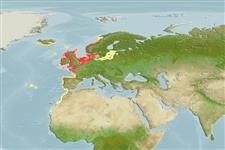Classification / Names
Common names from other countries
Main reference
Size / Weight / Age
Max length : 65.9 cm TL male/unsexed; (Ref. 40637); common length : 50.0 cm SL male/unsexed; (Ref. 4742); max. published weight: 4.4 kg (Ref. 40637); max. reported age: 29 years (Ref. 6843)
Length at first maturity
Lm ? range ? - ? cm
Environment
Marine; reef-associated; depth range 1 - 50 m (Ref. 5292), usually 2 - 30 m (Ref. 35388)
Climate / Range
Temperate, preferred 11°C (Ref. 107945); 64°N - 27°N, 32°W - 19°E
Distribution
Eastern Atlantic: Norway to Morocco, including Madeira, the Azores and the Canary Islands. Doubtful reports from Mediterranean, Adriatic and Marmara seas (Ref. 4742), where it is often confused with Labrus merula.
Countries | FAO areas | Ecosystems | Occurrences | Introductions
Short description
Body rather massive. Mouth small with thick lips and large conical teeth. Coloration very variable, brownish and greenish predominating (Ref. 35388).
IUCN Red List Status (Ref. 115185)
Threat to humans
Harmless
Human uses
Fisheries: subsistence fisheries; gamefish: yes; aquarium: commercial
More information
ReferencesAquacultureAquaculture profileStrainsGeneticsAllele frequenciesHeritabilityDiseasesProcessingMass conversion
Tools
Special reports
Download XML
Internet sources
Estimates of some properties based on models
Phylogenetic diversity index
PD50 = 0.5625 many relatives (e.g. carps) 0.5 - 2.0 few relatives (e.g. lungfishes)
Trophic Level
3.2 ±0.0 se; Based on diet studies.
Resilience
Low, minimum population doubling time 4.5 - 14 years (K=0.1; tmax=29; tm=2-9)
Vulnerability
High to very high vulnerability (67 of 100)
Price category
